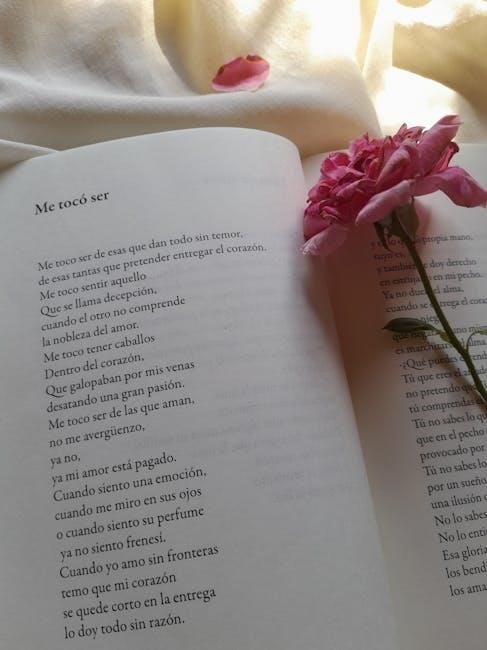Poem in PDF Format: Creation, Conversion, and Tools
Explore the world where poetry meets digital documents! This section unveils the intersection of poems and the PDF format, offering a guide to tools and methods. Discover how to create, convert, and enhance poems within PDFs, making them accessible and secure.
The realm of poetry finds a modern echo in the digital landscape, specifically within the Portable Document Format (PDF). This format is a versatile container, ensuring that the visual and textual integrity of a poem is preserved across different devices and platforms. Imagine crafting a beautiful verse and sharing it without worrying about formatting inconsistencies; that’s the power of poems in PDF format.
PDFs offer several advantages for poets and poetry enthusiasts. They provide a stable layout, ensuring that line breaks, stanzas, and special characters are displayed as intended. Furthermore, PDFs can be easily distributed, printed, and archived, making them an ideal medium for sharing and preserving poetic works.

From converting existing text or Word documents to creating visually stunning layouts, PDFs offer a canvas for creativity. Whether you’re a seasoned poet or just starting your poetic journey, understanding the tools and techniques for working with poems in PDF format can unlock new possibilities for expression and sharing.
This guide explores the various facets of poems in PDF format, from creation to conversion and enhancement, offering insights and resources to elevate your poetic endeavors.
Creating a Poem
The genesis of a poem is a deeply personal journey, often beginning with an inspiration, an emotion, or a simple observation. Whether you prefer pen and paper or a digital canvas, the initial step involves capturing your thoughts and arranging them into verses. Once you’ve crafted your poem, the next step is to digitize it, which brings us to the intersection of poetry and technology.
You can start by typing your poem directly into a word processor like Microsoft Word or a simple text editor. Pay close attention to formatting, ensuring that line breaks and spacing are preserved. Alternatively, if you’ve handwritten your poem, you can scan it or take a clear photograph.
For those seeking inspiration or a creative boost, numerous online tools can assist in the poem-writing process. AI poem generators, for instance, can create rhyming verses based on specific themes or keywords. These tools can be particularly helpful for overcoming writer’s block or exploring different poetic styles.
Remember, the creation process is iterative. Don’t be afraid to experiment with different words, structures, and forms until you achieve the desired effect. Once you’re satisfied with your poem, you’re ready to convert it into a PDF format, ensuring its preservation and easy sharing.
AI Poem Generators
Artificial intelligence has opened new avenues for creative expression, and AI poem generators stand as a testament to this. These tools utilize advanced natural language processing (NLP) to craft unique and original poems based on user inputs. Whether you’re seeking a specific theme, a particular style, or simply a spark of inspiration, AI poem generators can be valuable assets.

The process is typically straightforward: you provide the AI with keywords, a topic, or even a short paragraph, and the generator produces a poem based on that input. Some generators offer options to select the poem’s style, mood, and length, allowing for a degree of customization. The generated poems can range from simple rhyming verses to more complex and nuanced compositions.
While AI-generated poems may not possess the same depth and emotional resonance as those crafted by human poets, they can serve as excellent starting points or creative prompts. They can help overcome writer’s block, explore different poetic forms, or simply provide a fresh perspective on a particular subject.
Several AI poem generators are available online, each with its unique strengths and features. Experiment with different tools to find one that aligns with your creative preferences. Once you’ve generated a poem you like, you can then convert it into a PDF for easy sharing and preservation.
Converting Text to PDF for Poems
Once you’ve crafted your poem, preserving its formatting and ensuring its accessibility are crucial. Converting your poem from a simple text file to a PDF (Portable Document Format) offers numerous advantages. PDFs maintain consistent formatting across different devices and operating systems, ensuring your poem appears as intended regardless of where it’s viewed.
Fortunately, converting text to PDF is a straightforward process. Numerous online tools and software programs offer this functionality, often for free. These converters typically allow you to upload your text file (.txt) and instantly download the converted PDF version. Some tools even offer options to customize the PDF’s appearance, such as adding a title, author information, or adjusting the margins.
For poems with specific formatting requirements, such as line breaks or indentation, it’s essential to preview the converted PDF to ensure accuracy. If adjustments are needed, you can edit the original text file and reconvert it until the desired formatting is achieved. When selecting a text-to-PDF converter, prioritize those that offer high-quality results and maintain the integrity of your poem’s text.
By converting your poem to PDF, you create a shareable and easily printable document that preserves your creative work for posterity.
Converting Word Documents to PDF for Poems
Many poets prefer composing their work in word processors like Microsoft Word, enjoying the rich formatting options and editing capabilities. When your poem is finalized in a Word document (DOC or DOCX), converting it to PDF becomes the next logical step for sharing and preservation. Converting Word documents to PDF ensures that your poem’s formatting, fonts, and layout remain consistent across all devices and platforms.
Several methods exist for converting Word documents to PDF. Microsoft Word itself offers a built-in “Save as PDF” option, providing a seamless conversion process. Alternatively, numerous online PDF converters allow you to upload your Word document and download the converted PDF file. These online tools are often free and convenient, requiring no software installation.
Adobe Acrobat, a professional PDF software, also provides robust conversion capabilities, ensuring high-quality PDF output with precise formatting retention. When choosing a conversion method, consider the complexity of your poem’s formatting. For simple poems with basic formatting, online converters may suffice. However, for poems with intricate layouts or embedded images, using Microsoft Word’s built-in converter or Adobe Acrobat is recommended to ensure optimal results.
After conversion, always review the PDF to verify that the formatting accurately reflects your original Word document; This step ensures your poem is presented exactly as you intended.
Converting PDF to Editable Formats (Word, Text)
While PDFs are excellent for preserving formatting, they can be challenging to edit directly. If you need to modify a poem stored in PDF format, converting it back to an editable format like Word (DOC/DOCX) or plain text (TXT) becomes necessary. This process allows you to revise, reformat, or extract the poem’s content for other purposes.
Several online and offline tools facilitate PDF to editable format conversion. Adobe Acrobat offers a robust conversion feature, maintaining formatting as accurately as possible. Online PDF converters provide a convenient alternative, allowing you to upload your PDF and download the converted file in your desired format.
However, the accuracy of the conversion depends on the PDF’s complexity. Scanned PDFs or those with intricate layouts may require Optical Character Recognition (OCR) to extract the text accurately. OCR technology analyzes the PDF’s image and converts it into editable text. Tools like Xodo PDF Studio and online OCR converters offer this functionality.

When converting to plain text, formatting will be lost, but the poem’s raw text will be preserved. Choose the conversion method that best suits your editing needs and the PDF’s characteristics. Always proofread the converted document to correct any errors introduced during the conversion process.
PDF to Image Conversion for Poems
Converting a poem in PDF format to an image (e.g., JPG, PNG) can be useful for various purposes. Images are easily shareable on social media platforms, ideal for visual presentations, or can be embedded into websites and documents. Converting a poem to an image preserves its visual appearance and formatting, ensuring it’s displayed as intended.
Numerous online tools can convert PDFs to images quickly and easily. Simply upload your PDF, select your desired image format, and download the converted image. These tools often offer options to control image quality and resolution.
For more advanced control, desktop PDF editors like Adobe Acrobat provide refined image conversion settings. You can specify the DPI (dots per inch) for higher resolution images suitable for printing or adjust compression settings to reduce file size for online sharing.
Converting to an image also protects the poem from being easily copied or edited. While OCR (Optical Character Recognition) can extract text from images, it adds an extra layer of security. This is especially important for protecting original works.
Consider the intended use when choosing an image format. JPG is suitable for general use, while PNG preserves transparency and is ideal for graphics with text or logos. Experiment with different formats and settings to achieve the desired visual outcome for your poem.
Tools for Editing and Enhancing PDF Poems
Enhancing a PDF poem involves more than just correcting typos; it can encompass visual improvements, stylistic adjustments, and accessibility enhancements. Several tools cater to these needs, ranging from simple online editors to comprehensive desktop software.
Online PDF editors offer quick and convenient ways to make minor changes. These tools allow you to add text, highlight passages, insert shapes, and even add annotations directly to the PDF. They’re perfect for collaborative reviews or making simple edits on the fly.
For more extensive editing, consider desktop PDF editors like Adobe Acrobat Pro or Xodo PDF Studio. These programs provide advanced features such as OCR (Optical Character Recognition) for editing scanned poems, batch processing, and precise control over text formatting, font embedding, and layout adjustments.
Beyond basic editing, these tools also allow you to add interactive elements, such as hyperlinks to related resources or multimedia content to complement the poem. Security features like password protection and digital signatures can be employed to safeguard your work.
Experiment with different fonts, colors, and layouts to create a visually appealing presentation of your poem. Explore the use of watermarks to assert ownership and consider adding metadata to ensure proper attribution.
Security and Accessibility of PDF Poems
When preserving poems in PDF format, security and accessibility are paramount. Securing a PDF poem ensures its integrity and prevents unauthorized modifications, while accessibility guarantees that individuals with disabilities can experience the poem fully.
PDFs offer various security features, including password protection to restrict access and prevent unauthorized opening. Permissions can be set to control whether users can print, copy, or edit the document. Digital signatures can also be added to verify the author’s identity and ensure the poem hasn’t been altered since signing.

Accessibility in PDFs involves making the content usable for people with disabilities, such as visual impairments. This includes adding alternative text descriptions for images, ensuring proper document structure for screen readers, and using sufficient color contrast for readability.
When creating a PDF poem, use clear and concise language, avoid complex formatting that might confuse screen readers, and provide text equivalents for any non-text elements. Utilize heading styles to create a logical document outline, making navigation easier for all users.
Tools like Adobe Acrobat Pro offer accessibility checkers that can identify and help resolve accessibility issues within a PDF. By prioritizing security and accessibility, you can ensure that your PDF poems are both protected and inclusive.
